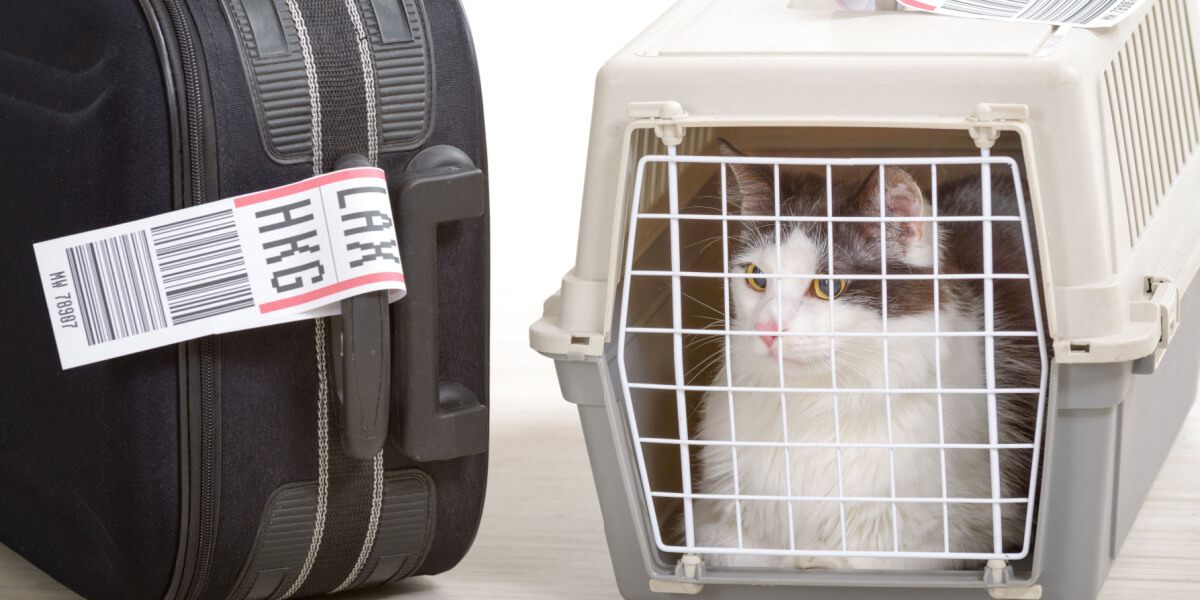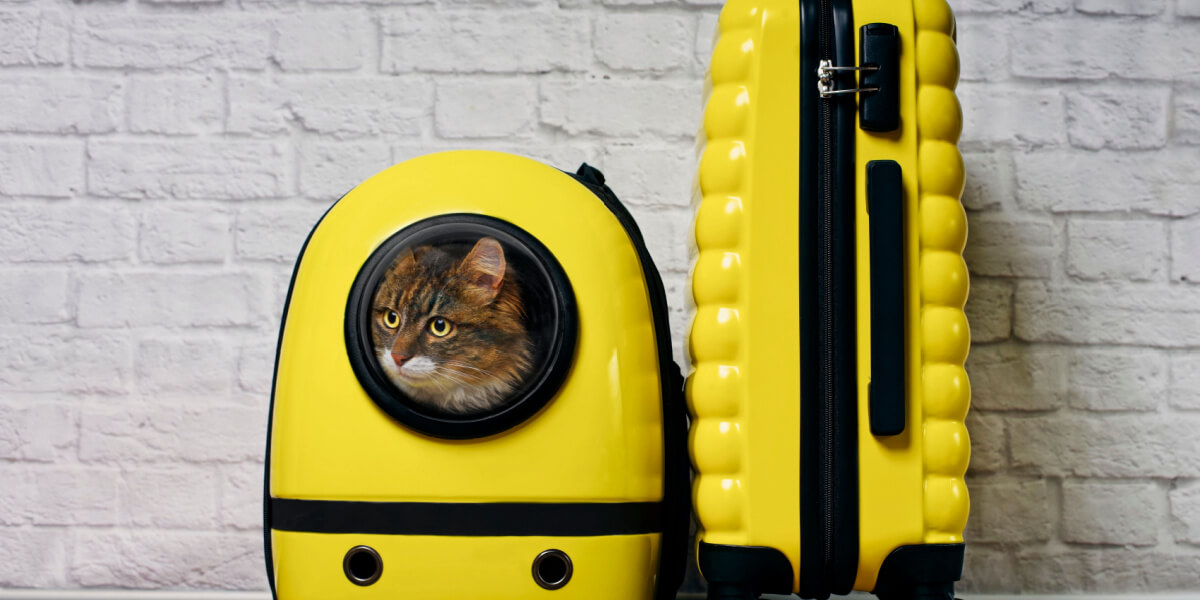
If you’re visiting family overseas, taking an extended holiday, or even emigrating, you might want or even need to take your cat on a plane. Whilst it might not be your kitty’s most enjoyable experience, there are lots of things you can do to ensure the trip is as stress-free as possible for both you and your cat.
Key Takeaways
Flying on a plane with your cat is possible, although they will have to travel in a secure pet carrier under the seat in front of you, or in the cargo hold.
Allow plenty of time to prepare to fly with your cat. The process of preparing travel documents and ensuring your cat has the correct documentation can be a lengthy one, sometimes taking several months.
Your veterinarian is the best person to ask for advice about flying with your cat. You will need their help to ensure your cat is up-to-date with their vaccinations and has all of the correct travel documentation to be able to fly with you.
If you’re planning to board a flight with your cat, you’ll want to be armed with as much knowledge as possible, and plan well ahead of your journey. Read on for the ultimate guide to flying with your cat.
Also Read: Should You Sedate A Cat For Travel?
Can I Board A Plane With My Cat?

Cats can travel either in the cabin or in the hold, depending on the airline.
The short answer is yes, you can! That being said, cat travel on a flight does require some careful planning and preparation. Most of the time, your cat will be able to travel with you in-cabin as your carry-on luggage, in a secure carrier that is placed under the seat in front of you.
Sometimes, however, it might be necessary for your cat to travel below in the cargo hold. This depends on where you are flying to and individual airline restrictions. Check with the airline what their rules are before you travel.
Bear in mind that whilst in certain circumstances it might be necessary to take your cat with you on a plane (for example if you are emigrating), in some instances it might be kinder to leave your cat at home with a pet sitter or book them into a cattery.
Some cats get extremely stressed even with a 5-minute car journey to the vet, or suffer from motion sickness. Ask yourself how your cat will cope on a much longer airplane journey. If your cat is super chilled about traveling in their carrier though, air travel probably won’t cause them too much distress.
Also Read: 5 Visual Signs Of A Stressed Cat And How To Help
Preparing To Fly With Your Cat

Being well prepared is essential for travel with pets.
There are several things cat owners need to do to prepare for pet travel, well before you take your cat on the airplane. Allow several months before your flight to ensure you have enough time to get all of the arrangements and required travel documents in place. Here are a few things you need to do before you travel.
Visit The Veterinarian
Taking your cat on a plane will involve liaising carefully with your veterinarian. The requirements for travel depend on your destination and you should visit the U.S. Department of Agriculture – Animal and Plant Inspection Service website to check the country’s requirements.
For most countries, a health certificate or pet passport will be required. This is completed by your veterinarian, usually within 10 days of travel, and states that your cat is healthy enough to travel and is up to date with the required vaccinations, usually including a rabies vaccination. Your cat must also have a working microchip.
In some circumstances, and for international travel, there will be other rules to comply with and additional certification that is required. There could be additional vaccinations and parasite treatments that need to be administered within a certain timeframe of travel, documents that need to be completed, and sometimes proof of a sufficient rabies titer. Some of these need to be prepared weeks to months in advance of your flight so it is best to book an appointment with your veterinarian as soon as possible.
Also Read: The 5 Best Large Cat Carriers For Travel
What To Consider When Booking A Flight
Try to book a non-stop flight with no layover if possible. This will shorten the journey for your cat and prevent any delays during transfers. Bear in mind that some airlines will only permit a certain number of pets to travel on a specific flight, and there may be some flights that do not allow pets at all. Book your flight early to ensure that your cat can travel with you.
Check The Airline Requirements

Different airlines, and different destinations, have varying pet travel requirements.
Some airlines may have their own requirements for your cat to travel with them. For example, most airlines will require an up-to-date health certificate from your veterinarian, even if your destination country does not.
You should check with the airline that your cat is allowed to travel in the cabin with you. Then obtain the exact weight and dimension requirements for your cat and their travel carrier as this will determine the size of the cat carrier you purchase. Your cat will have to stay in their carrier for the entire flight so ensure that it is as big as possible, whilst still complying with airline regulations.
Also Read: How To Get A Cat Into A Carrier: 6 Steps For Success
Prepare Your Cat For The Journey
Buy the pet carrier that your cat will be traveling in well in advance of your travel date. Leave your airline-approved carrier open in a room where your cat spends a lot of time so that they become used to the sight and smell of it. Allow them to investigate it in their own time and use plenty of treats to reward your cat for going in and out of it. You want your cat to form a positive association with the carrier so that they are as relaxed as possible when the time comes for them to go in it.
Once your cat is used to the carrier, begin to shut them in it for short periods, gradually building up to longer periods. Practice putting your cat into the carrier and taking them out again so that they become used to the process. You can use pheromone sprays such as Feliway, to help encourage your cat to feel safe and relaxed when they are in their carrier.
Also Read: Best Calming Aid For Cats
Essentials For Travel
Remember to take with you any cat food, water, bowls, treats, litter box, harness, lead, and wipes to clean up any accidents. Label your pet carrier with your up-to-date contact information just in case you get separated. Double-check that you have everything you need before you leave the house.
Ask Your Vet About Medication
If your cat suffers from severe anxiety when they travel, and you have no option but to fly with your cat, you might want to consider prescription sedatives from your veterinarian. Bear in mind that sedatives can pose mild health risks so your veterinarian will discuss with you the best options for your cat. They might suggest trialing the sedative at home before you travel, just in case your cat experiences any adverse effects.
In most cases, sedatives will not be required and natural calming supplements might be a better option for your cat. Talk to your veterinarian if you are unsure.
Also Read: 13 Common Cat Anxiety Medications: What You Need to Know
How To Look After Your Cat In The Airport

Airports can be busy and stressful places, so it is essential to plan how to keep your cat safe and calm.
Airports are usually busy, noisy places but after check-in, you can often find somewhere quieter to wait with your cat away from the main crowds. Talk to your cat softly to offer reassurance and opening the carrier a fraction to stroke your cat might help, although you do not want to risk your cat escaping in a busy airport!
Also Read: Why Do Cats Hate Long Car Rides? Here’s How To Help
At security, you will need to take your cat out of their carrier so that the carrier can go through the luggage x-ray screening machine. You will need to carry your cat through the human screening machine. Even if your cat is normally very happy to be held, bear in mind that an airport is likely to be much scarier than anywhere else they’ve been held and they might try and make a dash for it.
To prevent your cat from becoming lost in the airport, ensure they are wearing a harness with a lead attached. You will need to ensure that your cat is happy and used to wearing their harness before the day of travel so it’s best to introduce your cat to it several weeks beforehand.
Also Read: How To Make A Cat Feel Safe In 10 Simple Steps
Frequently Asked Questions
Is it safe for cats to fly on airplanes?
Most of the time, it is safe for cats to fly on airplanes. If your cat has a medical condition or is a brachycephalic breed, then check with your veterinarian that your cat is fit to travel.
Can I buy a seat for my cat on an airplane?
No, you cannot buy a seat on an airplane for your cat, but they do need to be booked on to the flight. Your cat will need to travel in a secure carrier under the seat in front of you, or in the cargo hold.
How do I get my cat to stop meowing on a plane?
Teach your cat to enjoy going in their pet carrier before you take them on a flight. You can use a pheromone spray to help your cat relax. You can try talking gently to your cat to reassure them whilst you are flying.







